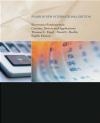Electronics Fundamentals
David Buchla, Thomas Floyd
Electronics Fundamentals
David Buchla, Thomas Floyd
- Producent: Pearson
- Rok produkcji: 2013
- ISBN: 9781292025681
- Ilość stron: 1064
- Oprawa: Miękka
Niedostępna
Opis: Electronics Fundamentals - David Buchla, Thomas Floyd
For DC/AC Circuits courses requiring a comprehensive, all inclusive text covering basic DC/AC Circuit fundamentals with additional chapters on Devices. This renowned text offers a comprehensive yet practical exploration of basic electrical and electronic concepts, hands-on applications, and troubleshooting. Written in a clear and accessible narrative, the Seventh Edition focuses on fundamental principles and their applications to solving real circuit analysis problems, and devotes six chapters to examining electronic devices.Electronics Fundamentals Part I DC Circuits Chapter 1 Quantities and Units 1-1 Scientific and Engineering Notation 1-2 Units and Metric Prefixes 1-3 Metric Unit Conversions 1-4 Measured Numbers 1-5 Electrical Safety Chapter 2 Voltage, Current, and Resistance 2-1 Atoms 2-2 Electrical Charge 2-3 Voltage 2-4 Current 2-5 Resistance 2-6 The Electric Circuit 2-7 Basic Circuit Measurements Application Assignment: Putting Your Knowledge to Work Chapter 3 Ohm's Law, Energy, and Power 3-1 Ohm's Law 3-2 Application of Ohm's Law 3-3 Energy and Power 3-4 Power in an Electric Circuit 3-5 The Power Rating of Resistors 3-6 Energy Conversion and Voltage Drop in a Resistance 3-7 Power Supplies 3-8 Introduction to Troubleshooting Application Assignment: Putting Your Knowledge to Work Chapter 4 Series Circuits 4-1 Resistors in Series 4-2 Total Series Resistance 4-3 Current in a Series Circuit 4-4 Application of Ohm's Law 4-5 Voltage Sources in Series 4-6 Kirchhoff's Voltage Law 4-7 Voltage Dividers 4-8 Power in Series Circuits 4-9 Voltage Measurements 4-10 Troubleshooting Application Assignment: Putting Your Knowledge to Work Chapter 5 Parallel Circuits 5-1 Resistors in Parallel 5-2 Total Parallel Resistance 5-3 Voltage in a Parallel Circuit 5-4 Application of Ohm's Law 5-5 Kirchhoff's Current Law 5-6 Current Dividers 5-7 Power in Parallel Circuits 5-8 Troubleshooting Application Assignment: Putting Your Knowledge to Work Chapter 6 Series-Parallel Circuits 6-1 Identifying Series-Parallel Relationships 6-2 Analysis of Series-Parallel Resistive Circuits 6-3 Voltage Dividers with Resistive Loads 6-4 Loading Effect of a Voltmeter 6-5 The Wheatstone Bridge 6-6 Thevenin's Theorem 6-7 The Maximum Power Transfer Theorem 6-8 The Superposition Theorem 6-9 Troubleshooting Application Assignment: Putting Your Knowledge to Work Chapter 7 Magnetism and Electromagnetism 7-1 The Magnetic Field 7-2 Electromagnetism 7-3 Electromagnetic Devices 7-4 Magnetic Hysteresis 7-5 Electromagnetic Induction 7-6 Applications of Electromagnetic Induction Application Assignment: Putting Your Knowledge to Work Part II AC Circuits Chapter 8 Introduction to Alternating Current and Voltage 8-1 The Sinusoidal Waveform 8-2 Sinusoidal Voltage Sources 8-3 Voltage and Current Values of Sine Waves 8-4 Angular Measurement of a Sine Wave 8-5 The Sine Wave Formula 8-6 Analysis of AC Circuits 8-7 Superimposed DC and AC Voltages 8-8 Nonsinusoidal Waveforms 8-9 The Oscilloscope Application Assignment: Putting Your Knowledge to Work Chapter 9 Capacitors 9-1 The Basic Capacitor 9-2 Types of Capacitors 9-3 Series Capacitors 9-4 Parallel Capacitors 9-5 Capacitors in DC Circuits 9-6 Capacitors in AC Circuits 9-7 Capacitor Applications Application Assignment: Putting Your Knowledge to Work Chapter 10 RC Circuits 10-1 Sinusoidal Response of RC Circuits 10-2 Impedance and Phase Angle of Series RC Circuits 10-3 Analysis of Series RC Circuits 10-4 Impedance and Phase Angle of Parallel RC Circuits 10-5 Analysis of Parallel RC Circuits 10-6 Analysis of Series-Parallel RC Circuits 10-7 Power in RC Circuits 10-8 Basic Applications 10-9 Troubleshooting Application Assignment: Putting Your Knowledge to Work Chapter 11 Inductors 11-1 The Basic Inductor 11-2 Types of Inductors 11-3 Series and Parallel Inductors 11-4 Inductors in DC Circuits 11-5 Inductors in AC Circuits 11-6 Inductor Applications Application Assignment: Putting Your Knowledge to Work Chapter 12 RL Circuits 12-1 Sinusoidal Response of RL Circuits 12-2 Impedance and Phase Angle of Series RL Circuits 12-3 Analysis of Series RL Circuits 12-4 Impedance and Phase Angle of Parallel RL Circuits 12-5 Analysis of Parallel RL Circuits 12-6 Analysis of Series-Parallel RL Circuits 12-7 Power in RL Circuits 12-8 Basic Applications 12-9 Troubleshooting Application Assignment: Putting Your Knowledge to Work Chapter 13 RLC Circuits and Resonance 13-1 Impedance and Phase Angle of Series RLC Circuits 13-2 Analysis of Series RLC Circuits 13-3 Series Resonance 13-4 Series Resonant Filters 13-5 Parallel RLC Circuits 13-6 Parallel Resonance 13-7 Parallel Resonant Filters 13-8 Applications Application Assignment Putting Your Knowledge to Work Chapter 14 Transformers 14-1 Mutual Inductance 14-2 The Basic Transformer 14-3 Step-Up and Step-Down Transformers 14-4 Loading the Secondary 14-5 Reflected Load 14-6 Impedance Matching 14-7 Nonideal Transformer Characteristics 14-8 Tapped and Multiple-Winding Transformers 14-9 Troubleshooting Application Assignment: Putting Your Knowledge to Work Part III Devices Chapter 15 Diodes and Applications 15-1 Introduction to Semiconductors 15-2 The PN Junction Diode 15-3 Diode Characteristics 15-4 Diode Rectifiers 15-5 Power Supplies 15-6 Special-Purpose Diodes 15-7 Troubleshooting Application Assignment: Putting Your Knowledge to Work Chapter 16 Transistors and Applications 16-1 DC Operation of Bipolar Junction Transistors (BJTs) 16-2 BJT Class A Amplifiers 16-3 BJT Class B Amplifiers 16-4 The BJT as a Switch 16-5 DC Operations of Field-Effect Transistors (FETs) 16-6 FET Amplifiers 16-7 Feedback Oscillators 16-8 Troubleshooting Application Assignment: Putting Your Knowledge to Work Chapter 17 The Operational Amplifier 17-1 Introduction to the Operational Amplifier 17-2 The Differential Amplifier 17-3 Op-Amp Parameters 17-4 Negative Feedback 17-5 Op-Amp Configurations with Negative Feedback 17-6 Op-Amp Impedances 17-7 Troubleshooting Application Assignment: Putting Your Knowledge to Work Chapter 18 Basic Op-Amp Circuits 18-1 Comparators 18-2 Summing Amplifiers 18-3 Integrators and Differentiators 18-4 Oscillators 18-5 Active Filters 18-6 Voltage Regulators Application Assignment: Putting Your Knowledge to Work Chapter 19 Special-Purpose Op-Amp Circuits 19-1 Instrumentation Amplifiers 19-2 Isolation Amplifiers 19-3 Operational Transconductance Amplifiers (OTAs) 19-4 Active Diode Circuits 19-5 Other Op-Amp Circuits Application Assignment: Putting Your Knowledge to Work Chapter 20 Measurement, Conversion, and Control 20-1 Temperature Measurement 20-2 Strain, Pressure, and Flow-Rate Measurements 20-3 Motion Measurement 20-4 Sample-and-Hold Circuits 20-5 Analog-to-Digital Conversion 20-6 Power-Control Circuits Application Assignment: Putting Your Knowledge to Work Appendices A Table of Standard Resistor Values B Capacitor Color Coding and Marking C The Current Source, Norton's Theorem, and Millman's Theorem D Devices Data Sheets E Field-Programmable Analog Arrays (FPAAs) Answers to Odd-Numbered Problems Glossary Index
Producent:
GPSR Pearson Central Europe Sp. z o.o.
ul. Szamocka 8
01-748 Warszawa (PL)
tel: 459 596 060
email: [email protected]
Szczegóły: Electronics Fundamentals - David Buchla, Thomas Floyd
Tytuł: Electronics Fundamentals
Autor: David Buchla, Thomas Floyd
Producent: Pearson
ISBN: 9781292025681
Rok produkcji: 2013
Ilość stron: 1064
Oprawa: Miękka
Waga: 2.27 kg



























